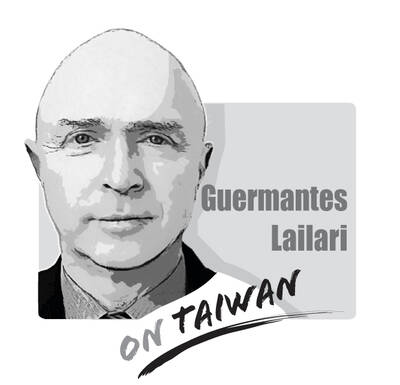Every day when we open social media, we are flooded with posts and images that are emotionally provocative, misleading and divisive. Among them are carefully crafted cognitive weapons curated for the purpose of manipulation and backed by long-standing infiltration networks from hostile foreign forces — especially the Chinese Communist party (CCP). The CCP has been systematically deploying artificial intelligence-generated content and fake accounts, as well as using information overload strategies to engage in a smoke-free cyberwar against Taiwan.
We must adopt a public health stance — treat disinformation like a virus and implement epidemic prevention strategies. Of course, though we cannot totally eliminate a virus outbreak, we could aim to reduce its transmission rate (R value) by cutting off its transference chains and building herd immunity.
The CCP’s cognitive warfare against Taiwan has three main characteristics: First, there is the mass generation of content, such as when the same message is repeatedly launched with different images, wordings and narratives. Second, repeated account duplication — once a propaganda account is exposed, another immediately takes its place. Third, cumulative strategies that merge disinformation with narrative manipulation, emotional provocation and coordinated performances by political figures, which, in turn, result in systemic offensive attacks.
These modes of dissemination mirror the organized and collective behavior of a biological virus, and are often sponsored by the CCP through allocated funding, linguistic model weaponization (an overloading of key words, phrasing and narratives that propagate the CCP’s political agenda), as well as state-affiliated content moderators.
In epidemiology, there is a key indicator termed the R value — representing how many people one infected individual can pass the virus to on average. If R > 1, the virus spreads exponentially; if R < 1, the outbreak will gradually fade, naturally dying off.
The spread of disinformation follows this pattern. Once you comment, share, or even like a post in the name of satire or criticism, algorithms automatically misinterpret the propaganda as valuable content and continue to promote it to other users. This inadvertently raises its R value, enabling it to spread faster through social networks.
The effective response is not to offer counterarguments against it, but to reduce its transmissibility: Block it, refuse engagement, and encourage others to block and report it as well. Additionally, spreading accurate information and linguistic antibodies — this is the true strategy for a cognitive epidemic prevention.
When hostile forces flood cyberspace with fake accounts, auto-generated content, and deliberately blur the line between reality and falsehood to cripple our empirical judgement, democratic societies must develop a form of digital immunity. This includes the strengthening of language and media literacy in education from a young age to cultivate cognitive antibodies; demanding transparency regarding social media algorithms and a mechanism to label content sources, thus curbing the unintentional spread of false information; forming communities that independently block, report and counter online disinformation campaigns; and urging politicians and influencers to exact self-restraint by refusing to become pawns to the CCP’s cyberwarfare.
We cannot completely eliminate disinformation, but we can prevent systemic paralysis. This requires a structured, scientific epidemic-control mindset, as well as collective action. Every time we report, block, or refrain from sharing, we become an antibody. Furthermore, every time we share correct information or infographics that neutralizes hostility, it is analogous to a vaccination — generating further immunity.
Yu Ming is a registered architect.
Translated by Lenna Veronica Suminski

“History does not repeat itself, but it rhymes” (attributed to Mark Twain). The USSR was the international bully during the Cold War as it sought to make the world safe for Soviet-style Communism. China is now the global bully as it applies economic power and invests in Mao’s (毛澤東) magic weapons (the People’s Liberation Army [PLA], the United Front Work Department, and the Chinese Communist Party [CCP]) to achieve world domination. Freedom-loving countries must respond to the People’s Republic of China (PRC), especially in the Indo-Pacific (IP), as resolutely as they did against the USSR. In 1954, the US and its allies
A response to my article (“Invite ‘will-bes,’ not has-beens,” Aug. 12, page 8) mischaracterizes my arguments, as well as a speech by former British prime minister Boris Johnson at the Ketagalan Forum in Taipei early last month. Tseng Yueh-ying (曾月英) in the response (“A misreading of Johnson’s speech,” Aug. 24, page 8) does not dispute that Johnson referred repeatedly to Taiwan as “a segment of the Chinese population,” but asserts that the phrase challenged Beijing by questioning whether parts of “the Chinese population” could be “differently Chinese.” This is essentially a confirmation of Beijing’s “one country, two systems” formulation, which says that
On Monday last week, American Institute in Taiwan (AIT) Director Raymond Greene met with Chinese Nationalist Party (KMT) lawmakers to discuss Taiwan-US defense cooperation, on the heels of a separate meeting the previous week with Minister of National Defense Minister Wellington Koo (顧立雄). Departing from the usual convention of not advertising interactions with senior national security officials, the AIT posted photos of both meetings on Facebook, seemingly putting the ruling and opposition parties on public notice to obtain bipartisan support for Taiwan’s defense budget and other initiatives. Over the past year, increasing Taiwan’s defense budget has been a sore spot
Media said that several pan-blue figures — among them former Chinese Nationalist Party (KMT) chairwoman Hung Hsiu-chu (洪秀柱), former KMT legislator Lee De-wei (李德維), former KMT Central Committee member Vincent Hsu (徐正文), New Party Chairman Wu Cheng-tien (吳成典), former New Party legislator Chou chuan (周荃) and New Party Deputy Secretary-General You Chih-pin (游智彬) — yesterday attended the Chinese Communist Party’s (CCP) military parade commemorating the 80th anniversary of the end of World War II. China’s Xinhua news agency reported that foreign leaders were present alongside Chinese President Xi Jinping (習近平), such as Russian President Vladimir Putin, North Korean leader Kim